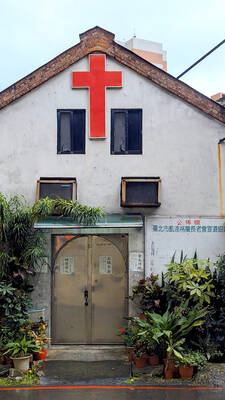Richard Rogers may be one of the greatest living architects, but he is far less well known than the buildings he designs. The Pompidou Center, Millennium Dome and Lloyd’s of London are among the more iconic structures that testify to Rogers’ unique vision. A retrospective exhibit at the Taipei Fine Arts Museum, Richard Rogers + Architects: From the House to the City offers a comprehensive look at the architect’s career over the past 40 years.
“It’s nice to know that although we’ve toured the exhibition, this is the grandest space so far. The smallest space was London,” Ivan Harbour, a partner at Rogers’ architectural firm Rogers Stirk Harbour + Partners, quipped at a preview of the show.
Rogers, who missed the opening due to the death of a close friend, works and lives in London. Harbour and Graham Stirk were on hand to introduce the exhibit.
“We’ve been working in Taiwan for about 10 years now. We’ve built two modest buildings in Kaohsiung and been involved in many competitions — all of which we’ve lost,” Harbour said.
Harbour’s self-deprecating humor corresponds with Rogers’ approach to architecture, which is both playful and human-centered. Underlying the levity, however, is a concern “with the processes of construction and the way that people relate to the buildings around them.” It is an ethos that they’ve applied to this show.
Each of the nine thematic areas — Early Work, Transparent, Lightweight, Legible, Green, Public, Systems, Urban and Work in Progress — offer visitors a grounding in the ideas that inform Rogers’ approach to architecture. Together they include 78 new and archive models, 80 drawings, 160 photographs, 22 videos and a timeline illustrating the development of Rogers’ architectural practice. Arranged in easily digestible color-coded blocks, there are designs of airports, galleries, courts and government buildings, as well as housing projects, each accompanied with explanations of materials used and purpose of construction.
The two Kaohsiung-based buildings Harbour alluded to illustrate Rogers’ ideas of space and how buildings should suit the environment within which they are erected.
The Ching Fu Group Headquarters (慶富船運大樓) with its exposed columns and primary color finishings recalls the Pompidou Center, but here with the addition of external glass boxes that serve as meeting rooms and offer views of the harbor. Built between 2005 and 2007, the self-cooling structure is an example of the kind of energy-saving building ideally suited for Taiwan’s climate.
Whereas the Ching Fu building emphasizes environmental concerns, the R9 Central Park Station (捷運R9中央公園站) on the Kaohsiung MRT’s red line exemplifies Rogers’ belief that a building should fit fluidly within its surroundings.
The design merges the concourse with the surrounding landscape, enabling the station to seamlessly unite with the expansive greenery of the park. A 50m-by-50m aluminum canopy lets natural light in while reflecting the sun’s glare and protecting passengers from the rain.
Remarking candidly at the press conference on Rogers’ comprehensive approach to architecture, Christine Skinner, outgoing director of the British Council, said the Taipei City Government could learn a thing or two from the exhibit.
“There are parts of Taipei that have obviously been developed in a holistic way,” she said referring to Xinyi (信義) and Neihu (內湖) districts.
“But there are other parts of Taipei where that planning is not happening and buildings are conceived one by one ... [Y]ou do get a feeling that not a lot of urban planning has gone on and I think that is something that Taipei in particular needs to put right,” she said.

The Directorate-General of Budget, Accounting and Statistics (DGBAS) told legislators last week that because the Chinese Nationalist Party (KMT) and Taiwan People’s Party (TPP) are continuing to block next year’s budget from passing, the nation could lose 1.5 percent of its GDP growth next year. According to the DGBAS report, officials presented to the legislature, the 2026 budget proposal includes NT$299.2 billion in funding for new projects and funding increases for various government functions. This funding only becomes available when the legislature approves it. The DGBAS estimates that every NT$10 billion in government money not spent shaves 0.05 percent off

It is a soulful folk song, filled with feeling and history: A love-stricken young man tells God about his hopes and dreams of happiness. Generations of Uighurs, the Turkic ethnic minority in China’s Xinjiang region, have played it at parties and weddings. But today, if they download it, play it or share it online, they risk ending up in prison. Besh pede, a popular Uighur folk ballad, is among dozens of Uighur-language songs that have been deemed “problematic” by Xinjiang authorities, according to a recording of a meeting held by police and other local officials in the historic city of Kashgar in

Dec. 29 to Jan. 4 Like the Taoist Baode Temple (保德宮) featured in last week’s column, there’s little at first glance to suggest that Taipei’s Independence Presbyterian Church in Xinbeitou (自立長老會新北投教會) has Indigenous roots. One hint is a small sign on the facade reading “Ketagalan Presbyterian Mission Association” — Ketagalan being an collective term for the Pingpu (plains Indigenous) groups who once inhabited much of northern Taiwan. Inside, a display on the back wall introduces the congregation’s founder Pan Shui-tu (潘水土), a member of the Pingpu settlement of Kipatauw, and provides information about the Ketagalan and their early involvement with Christianity. Most

The People’s Republic of China (PRC) was out in force in the Taiwan Strait this week, threatening Taiwan with live-fire exercises, aircraft incursions and tedious claims to ownership. The reaction to the PRC’s blockade and decapitation strike exercises offer numerous lessons, if only we are willing to be taught. Reading the commentary on PRC behavior is like reading Bible interpretation across a range of Christian denominations: the text is recast to mean what the interpreter wants it to mean. Many PRC believers contended that the drills, obviously scheduled in advance, were aimed at the recent arms offer to Taiwan by the